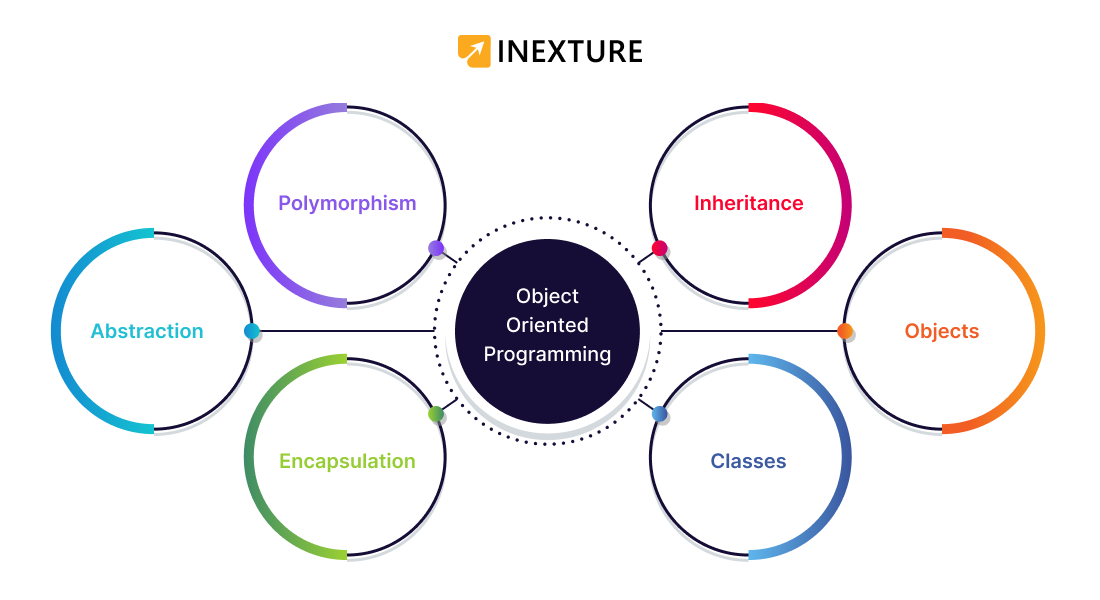Crypto Wallet App Development: Features,...
April 14, 2025

Object-oriented programming (OOP) is an important branch of computer science that makes complex systems more usable. It is achieved by using “objects” to represent data and actions that can be performed on it. This simplifies and organizes the software, making it more flexible and easier to handle.
In this guide, we will see the simplest object-oriented languages for beginners. Whether you want to make desktop software, mobile apps, or websites, these languages are a great starting point. They are easy to pick up, have a strong user base, and they can be used for other programs as well. Let’s plunge and finish finding the most suitable solutions for beginners in programming.
Object-oriented programming (OOP) is a way of formulating programs in a way that groups the programmer’s focus around data, or these are known as “objects” rather than instructions and the logic that carries them out.
The base is something that has special attributes that present action-like data. Rather than emphasizing the process of getting the job done by defining given procedures, OOP focuses on establishing objects which people are supposed to work with.
This method their relevance is undeniable, especially when it comes to programs for production and designing, like those used in software development or mobile apps. Object-oriented programming is one of the most popular views that is used in simulating software for manufacturing processes. This method is also effective for team assignments where you can allocate the task into various pieces and different groups can handle different parts of the program. 
One of the main advantages of OOP is that it makes it possible to reuse class definitions, and this facilitates a lot of effort and time savings. Thanks to this flexibility, they can be applied to many different data amounts, and make incremental changes while fulfilling the new requirements.
When working with an OOP framework programmers normally start with determining what kind of objects are required and the interactions that will transpire between them – this is referred to as data modeling. Objects can be anything from a person to a business entity representing a human contact that can be described by their name and address or even small objects inside a program like widgets.
After the object is defined, it is placed into the class which is described by the computer what data it can hold, and what actions it can perform. Relationships between the objects are set via the well-defined concept of a message. It helps a lot in maintaining the program and its structure as it can be changed and improved in the future.
Instruction-based programming (OOP) consists of an architecture of several key components, built out of building bricks, to represent the main parts of Object-Oriented Programming. These include classes, objects, methods, and attributes, with each one of them being of prime importance, as it is in this way they define the organizational style and behavior of the program.
As a class constitutes the blueprint, everyone will have a common goal, and each of you will develop the skills that are necessary to realize your own version of the end product. In Object-Oriented Programming, a class is the user-defined user’s own data type that it forms as an individual kind of object including its features on what it will be like (the data it holds) and what kind of actions it can perform (the methods). While the instructor doesn’t include any actual object, it specifies how a class participant will look, and act according to the object when they summon it.
If a class defines the blueprint, the object depicts the building built according to that blueprint. Notice how objects are wishing for classes. It means that an object that stores the specifically defined data scope that is based on the class is created from the class. Objects can either represent the physical world subjects like a car or a person or be more abstract, it pertains to whatever the program needs to accomplish.
Methods are akin to functions found in procedural programming, but they are defined within a class and are designed to describe the behaviors of objects. Each method in a class typically starts with a reference to an instance of the class (an object), enabling the method to access and manipulate the data within that instance. Methods help in reusing code and keeping functionality contained within objects, making programs more modular and easier to manage.
Attributes are those denominators of classes that tell what the characteristics of the objects are. They are the same objects being referred to in the sentence. Such an object would possess an attribute that may be ‘color’ or ‘make’ when it comes to a ‘Car’ class. Attributes can be an object’s contextual (instance attributes) or attributes known by all objects instantiated from this class (class attributes).
These elements work together to form the foundation of any object-oriented program, promoting a modular, scalable, and manageable approach to software development.
Object-oriented programming (OOP) is a programmatic approach based on the concept of “objects”, that can hold data in the form of fields, and procedures to operate on such data, which is often called attributes properties, and methods.
Object-oriented programming Languages are delightfully considerate when it comes to modularity, reusability, and flexible software development, which makes them a perfect fit for complex programs. Here’s a look at some of the top OOP languages suitable for beginners: Here’s a look at some of the top Object-Oriented Programming Languages suitable for beginners:
Java is referred to as being fully portable across platforms starting from the desktop and down to mobile phones through the use of Java Virtual Machine (JVM) base technology. Its strength and the strong community behind it are the factors that make it a choice project for the new, developing community. Java’s strong encapsulation, polymorphism, and inheritance capabilities make it a solid choice for robust Mobile App Development.
Python is a language with a simple and intuitive way of commanding structures which makes the education process both easy to understand for beginners. Therefore, the algorithm is accessible to those who are just beginning to learn. It is also part of this. This lets it support the functional paradigm and other structuring methods such as procedural programming. Python Development is widely used in scientific computing, web development, automation, and many other applications.
Learn | Python Environment Variables: A Step-by-Step Tutorial for Beginners
C++ is regarded as a high-middle tier language which gives it the features both high-level languages and low-level languages possess and that makes C++ the preferred language for developing embedded firmware and easily portable applications. Known for its speed and high efficiency, C++ is employed in game development, real-time systems, and software that at a high level needs to perform powerful math calculations.
Ruby values the top objects in both simplicity and productivity pointing out the very readable nature of the syntax using easy writing. It is due to the emergence of the Ruby on Rails framework that web development could be able to use it and the community consisting of extremely active members will continue contributing a lean support tool along with documentation since this will be loved by the startups and web developers the framework will be the most prevailing in future.
The initial purpose of this (technique) was to solicit runners and makers of web apps, and (to be user-friendly), it will likely transform into a general programming language one such day. To name a few, it is the most famous language that combines with a server-side scripting technique which is used to create dynamic web page contents that include images among others. PHP programming language, being very easy to grasp, and having a broad audience, serves as a good basis whereby someone who is new to programming, or wishes to create easy fast websites can get started.
C#langauge was created by Microsoft and assigned under the .NET framework. The language has strong type-checking support, and bounds detection for arrays and it takes care of memory issues by using garbage collection which increases the safety and performance of the development process.
In addition to JavaScript being a super-set of TypeScript, this language has been developed with static typing and is appropriate for building large applications. This one converts TypeScript into JavaScript which means that this can work on any browser or JavaScript engine. Other than the errors of developers, its superior tooling and compilation phase do that.
These languages each offer unique features and communities, making them suitable for a variety of development tasks and accessible for newcomers to programming.
In conclusion, choosing the right object-oriented programming language as a beginner can significantly influence your journey in Software Development. Each language discussed offers a unique blend of features and community support, making them all viable options depending on your specific needs and interests.
Whether you plan to develop applications locally or are considering engaging with an Offshore Software Development Company, these languages provide a robust foundation for building versatile and scalable applications. As you embark on your programming adventure, remember that the key to mastering any language is consistent practice and continuous learning.